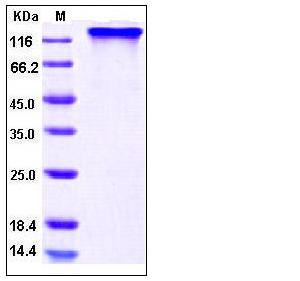Human HER4 / ErbB4 Protein (His & Fc Tag)
ALS19,HER4,p180erbB4
- 100ug (NPP3845) Please inquiry
| Catalog Number | P10363-H03H |
|---|---|
| Organism Species | Human |
| Host | Human Cells |
| Synonyms | ALS19,HER4,p180erbB4 |
| Molecular Weight | The recombinant human ErbB4/Fc is a disulfide-linked homodimeric protein after proteolytic removal of the signal peptide. The reduced monomer consists of 871 amino acids and predicts a molecular mass of 97.5 kDa. As a result of glycosylation, the rh ErbB4/Fc monomer migrates as approximately 125-135 kDa band in SDS-PAGE under reducing conditions. |
| predicted N | Glu 26 |
| SDS-PAGE |  |
| Purity | > 95 % as determined by SDS-PAGE |
| Protein Construction | A DNA sequence encoding the extracellular domain (Met 1-Pro 651) of human ErbB4 precursor (NP_001036064.1) was fused with the C-terminal His-tagged Fc region of human IgG1 at the C-terminus. |
| Bio-activity | 1. Measured by its ability to bind biotinylated human Fc-NRG1 (isoform Beta 1) (P11609-H01H) in a functional ELISA. 2. Measured by its ability to bind with biotinylated human NRG1 (isoform Beta 1) (P11609-H01H2) in a functional ELISA. 3. Measured by its ability to bind with biotinylated human NRG1 (aa 2-246)-Fc (P11609-H04H) in a functional ELISA. 4. Measured by its ability to bind with biotinylated human NRG1 (aa 20-241)-His (P13499-H08H) in a functional ELISA. |
| Research Area | Cancer |Invasion microenvironment |Angiogenesis |Growth Factor & Receptor |Receptor Tyrosine Kinase (RTK) |
| Formulation | Lyophilized from sterile PBS, pH 7.4 1. Normally 5 % - 8 % trehalose, mannitol and 0.01% Tween80 are added as protectants before lyophilization. Specific concentrations are included in the hardcopy of COA. |
| Background | ERBB4 is a single-pass type I membrane protein with multiple cysteine rich domains, a transmembrane domain, a tyrosine kinase domain, a phosphotidylinositol-3 kinase binding site and a PDZ domain binding motif. ERBB4 is expressed at highest levels in brain, heart, kidney, in addition to skeletal muscle, parathyroid, cerebellum, pituitary, spleen, testis and breast. And lower levels in thymus, lung, salivary gland, and pancreas. It specifically binds to and is activated by neuregulins, NRG-2, NRG-3, heparin-binding EGF-like growth factor, betacellulin and NTAK. ERBB4 also can be activated by other factors and induces a variety of cellular responses including mitogenesis and differentiation. ERBB4 regulates development of the heart, the central nervous system and the mammary gland, gene transcription, cell proliferation, differentiation, migration and apoptosis. It is required for normal cardiac muscle differentiation during embryonic development, and for postnatal cardiomyocyte proliferation. ERBB4 also play a role on the normal development of the embryonic central nervous system, especially for normal neural crest cell migration and normal axon guidance. It is required for mammary gland differentiation, induction of milk proteins and lactation. |
| Reference |
